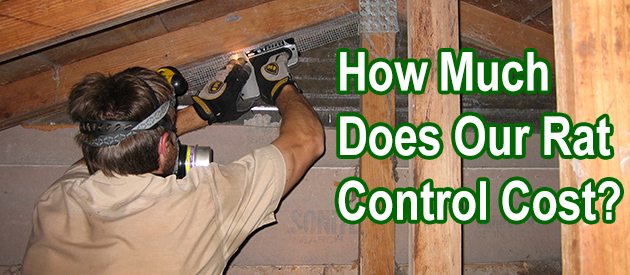Los Angeles County, Los Angeles Rat Control Situation:
Hi David, I'm in southern California. I have at least one rat in my ceiling, maybe two or more. I've read your website and really appreciate the great insight you're providing. Based on your advice, I've caught 3 rats around the outside my house (over the last 2 months), trimmed trees back (3 days ago), and plugged all the access holes I could identify (3 weeks ago).
Yet I still have at least one rat in my attic. Though I've place several snap traps (baited with peanut butter and bird seed) in the attic, I get no nibbles. I also cannot find any evidence of their paths. I've moved the trap several time with no success. From inside the house, I hear them in sections of the attic (about 3:00 am) that are completely inaccessible to me (because of firewalls.)
So I hired a pest extermination company. For $275 they put some poison bait stations outside, and three snap traps in the attic that are baited with a beef jerkey substance. The traps are near the attic access panel - not near the rat noise activity. The guy's reply was that the scent would lure them. He also reviewed my hole-plugging and said it was fine. He didn't get onto my roof. It's been three days and I check the snap traps in the morning and around dusk each night.
My questions are:
1. Is it safe to assume that the rat(s) sleep in my house during the day and at night they are coming and going outside? Does this mean I've missed an access point?
2. Considering the inaccessibility, is it common to drill a hole in the ceiling (like a 4" hole for recessed lighting) to place traps in the attic for those inaccessible places? If I drill a hole, then I can stick a camera up there and take pictures to look for evidence, place the traps, monitor them, etc. But then I've got a hole to deal with.
3. Is it worth parking myself on the roof and patiently waiting to see where the rats are coming and going?
4. Have I given the beef jerkey snap-traps enough time to do their thing? Any other advice? Thanks for your help!
Los Angeles Rat Control Tip of The Week
How Can I Get Rid Of A Rat In My Bedroom?
Fill In Gaps And Cracks:
It's likely that there could be areas across your bedroom where rats can easily enter into your home. This could mean filling in cracks and gaps along the baseboard of your room or at the top of your room where the ceiling meets it. Filling in these gaps and cracks will make sure that a rat cannot enter and leave freely.
Remove Food:
If you regularly keep old plates and food in your bedroom it is important to remove these items and clean up your room as quickly as possible. More areas for rats to hide and more food sources will make sure that a rat will continually go back to that room.
Trim Overhanging Branches:
If you have branches that overhang to a window in your bedroom or hang close to the roof of your bedroom, you should trim them back as this can be a perfect way that rats can access your property.
Set Traps That Are Not Dangerous To Pets:
It's likely that you still want to have your pets in your bedroom so you will need to use a trap that is safe for your room and that will also be widely effective at catching rats. Making sure that you are using a safe trap to remove a rat is a great way to capture an animal that has been getting into your bedroom. Rats can spread poison easily so you should never consider using a poison trap, especially in the bedroom.
Remove Nesting Material Often:
If you find nesting material around your bedroom or in the walls, make sure that you are removing it often to discourage rats from breeding and setting up for a long time in your room.


